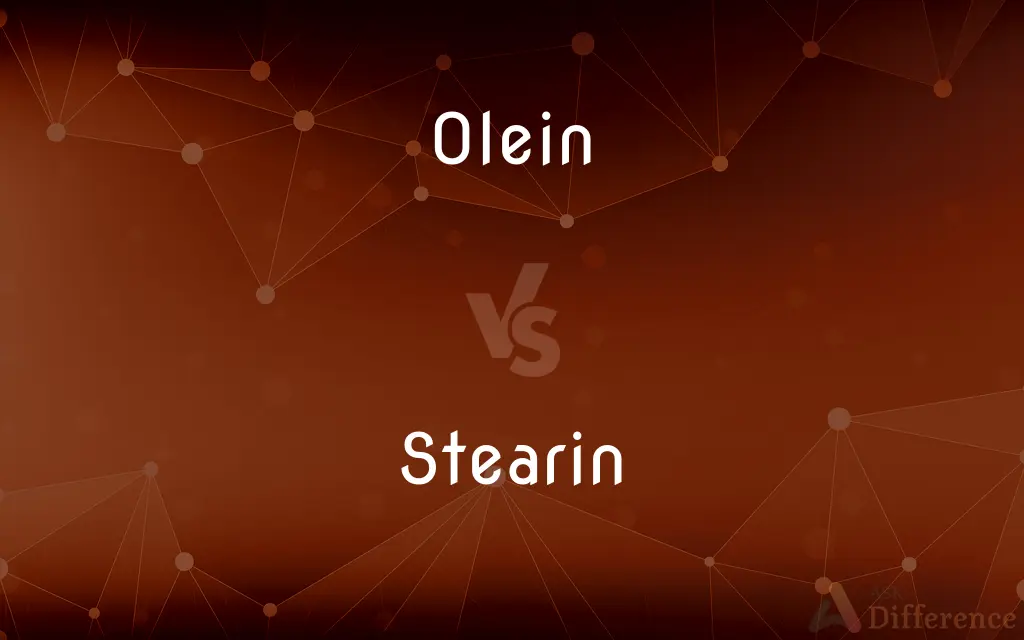Olein vs. Stearin — What's the Difference?
By Tayyaba Rehman & Urooj Arif — Updated on April 6, 2024
Olein is a liquid fraction of fat, known for its lower melting point, whereas stearin is the solid fraction with a higher melting point.

Difference Between Olein and Stearin
Table of Contents
ADVERTISEMENT
Key Differences
Olein, or triolein, is a component of fat that remains liquid at room temperature, making it a crucial ingredient in oils and soft spreads. On the other hand, stearin is the solid part of fat, known for its higher melting point, which is used in the production of harder fats and candles.
While olein is celebrated for its application in the food industry, particularly in cooking and salad oils due to its fluidity and health benefits, stearin finds its use not only in food products like shortening and margarine but also in non-food items such as candles, soaps, and cosmetics. This highlights the versatility of fats and their components based on physical states and melting points.
The extraction and separation of olein and stearin from fats involve processes like fractionation, where olein is separated due to its lower melting point, allowing it to remain liquid when the fat is partially cooled. Stearin, meanwhile, solidifies during this process and is separated for its distinct uses, emphasizing the importance of physical properties in the utilization of fat components.
In terms of nutritional content, olein tends to be richer in unsaturated fats, making it a preferred choice for those seeking healthier fat options. Stearin, while also containing a mix of saturated and unsaturated fats, has a higher proportion of saturated fats, which are often linked to higher cholesterol levels if consumed in excess.
The market demand for olein and stearin varies based on their applications. Olein's demand is primarily driven by the food industry for its liquid form at room temperature, making it ideal for cooking and food preparation. Stearin’s demand, however, comes from both the food industry for producing solid fats and the manufacturing sector for non-food products, illustrating the diverse applications of these fat components.
ADVERTISEMENT
Comparison Chart
State at Room Temperature
Liquid
Solid
Melting Point
Lower
Higher
Primary Use
Cooking oils, soft spreads
Shortening, candles, cosmetics
Nutritional Content
Higher in unsaturated fats
Higher in saturated fats
Extraction Process
Separated at higher temperatures
Solidifies and separated at lower temperatures
Compare with Definitions
Olein
A liquid fraction of fat, rich in unsaturated fats.
Olein is often used to produce lighter cooking oils.
Stearin
The solid fraction of fat, known for its higher melting point.
Stearin is utilized in making solid cooking fats.
Olein
Preferred for its unsaturated fat content.
Dieticians recommend olein-based oils for a healthier diet.
Stearin
Contains a higher proportion of saturated fats.
Consuming foods high in stearin can affect cholesterol levels.
Olein
Remains liquid at room temperature.
Olein's liquid form makes it ideal for salad dressings.
Stearin
Results from cooling and solidifying fat.
Stearin is extracted by allowing the fat to cool down and separate.
Olein
Obtained through fat fractionation.
Olein is separated from solid fats at controlled temperatures.
Stearin
Used in both food and non-food products.
Apart from cooking fats, stearin is essential in manufacturing soaps and candles.
Olein
Widely used in the food industry.
Olein is a key ingredient in liquid vegetable oils.
Stearin
Solidifies at room temperature.
Stearin is used in candles due to its solid state at room temperature.
Olein
The triglyceride, C57H104O6, of oleic acid, occurring naturally in most fats and oils as an oily, yellow liquid and used as a textile lubricant.
Stearin
Stearin , or tristearin, or glyceryl tristearate is an odourless, white powder. It is a triglyceride derived from three units of stearic acid.
Olein
Any naturally-occurring greasy or oily substance related to fat
Stearin
See tristearin.
Olein
(chemistry) Any glyceride of oleic acid
Stearin
The solid form of fat.
Olein
A fat, liquid at ordinary temperatures, but solidifying at temperatures below 0° C., found abundantly in both the animal and vegetable kingdoms (see Palmitin). It dissolves solid fats, especially at 30-40° C. Chemically, olein is a glyceride of oleic acid; and, as three molecules of the acid are united to one molecule of glycerol to form the fat, it is technically known as triolein. It is also called elain.
Stearin
Solid fat.
Olein
A naturally occuring glyceride of oleic acid that is found in fats and oils
Stearin
(organic compound) A glyceride (especially the triglyceride) of stearic acid
Stearin
One of the constituents of animal fats and also of some vegetable fats, as the butter of cacao. It is especially characterized by its solidity, so that when present in considerable quantity it materially increases the hardness, or raises the melting point, of the fat, as in mutton tallow. Chemically, it is a compound of glyceryl with three molecules of stearic acid, and hence is technically called tristearin, or glyceryl tristearate.
Stearin
An ester of glycerol and stearic acid
Common Curiosities
What is olein?
Olein is the liquid fraction of fat, commonly used in cooking oils for its unsaturated fat content.
How are olein and stearin extracted?
They are extracted through fractionation, where fats are partially cooled, separating olein in its liquid form and stearin as a solid.
Can stearin be used in food products?
Yes, stearin is used in food products like shortening and margarine, where a solid fat is preferred.
Is stearin only used in the food industry?
No, stearin is also used in the manufacturing of candles, soaps, and cosmetics, among other non-food items.
How does the physical state of olein and stearin affect their use?
Olein’s liquid state makes it suitable for oils and spreads, while stearin’s solid state is ideal for producing hard fats and non-food items.
Which is healthier, olein or stearin?
Olein is considered healthier due to its higher content of unsaturated fats, which are better for heart health.
What is stearin?
Stearin is the solid fraction of fat, utilized in making solid fats and various non-food items for its higher melting point.
What are the main uses of olein?
Olein is primarily used in the food industry for cooking oils and soft spreads due to its liquid state at room temperature.
Why do some people prefer olein-based oils?
People prefer olein-based oils for their fluidity and healthier fat composition, ideal for cooking and salads.
How do nutritional contents of olein and stearin differ?
Olein is higher in unsaturated fats, beneficial for heart health, whereas stearin contains more saturated fats, which can be less healthy in large amounts.
Why is stearin used in candles?
Stearin's solid state at room temperature and higher melting point make it suitable for candle making, providing structure and stability.
Are olein and stearin present in all fats?
Yes, most natural fats contain both olein and stearin in varying proportions, depending on the type of fat.
What distinguishes olein from stearin in the food industry?
Olein is used for liquid cooking products due to its liquid form, while stearin is preferred for solid fat products like shortening.
How does the extraction process impact olein and stearin?
The extraction process, through controlled temperature and cooling, ensures the separation of olein and stearin based on their melting points.
Can olein and stearin affect cholesterol levels?
Yes, olein, with its unsaturated fats, can help maintain healthy cholesterol levels, whereas stearin's saturated fats might increase cholesterol if consumed in excess.
Share Your Discovery

Previous Comparison
General vs. Generic
Next Comparison
Rip vs. ZipAuthor Spotlight
Written by
Tayyaba RehmanTayyaba Rehman is a distinguished writer, currently serving as a primary contributor to askdifference.com. As a researcher in semantics and etymology, Tayyaba's passion for the complexity of languages and their distinctions has found a perfect home on the platform. Tayyaba delves into the intricacies of language, distinguishing between commonly confused words and phrases, thereby providing clarity for readers worldwide.
Co-written by
Urooj ArifUrooj is a skilled content writer at Ask Difference, known for her exceptional ability to simplify complex topics into engaging and informative content. With a passion for research and a flair for clear, concise writing, she consistently delivers articles that resonate with our diverse audience.















































